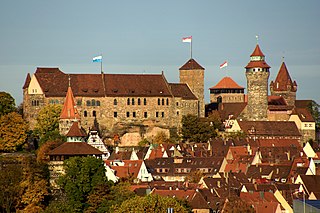
Nuremberg is the largest city in Franconia, the second-largest city in the German state of Bavaria, and its 545,000 inhabitants make it the 14th-largest city in Germany.

Oflag XIII-B was a German Army World War II prisoner-of-war camp for officers (Offizierslager), originally in the Langwasser district of Nuremberg. In 1943 it was moved to a site 3 km (1.9 mi) south of the town of Hammelburg in Lower Franconia, Bavaria, Germany.
Stalag XIII-D Nürnberg Langwasser was a German Army World War II prisoner-of-war camp built on what had been the Nazi party rally grounds in Nuremberg, northern Bavaria.
Oflag XIII-A, Oflag XIII-B and Oflag XIII-D were all German World War II prisoner-of-war camp for officers (Offizierlager). They were all located on the old Nazi party rally grounds in Langwasser, Nuremberg, in northern Bavaria. They were adjacent to Stalag XIII-D.
Langwasser is a part (Stadtteil) of Nuremberg in the southeastern area of the city. It was developed as a prototype of the satellite town concept in the 1960s and is primarily a suburban residential area. The name Langwasser, comes from a small stream bordering the area on its eastern edge.
The following is a timeline of the history of the German city of Leipzig.
The following is a timeline of the history of the city of Dresden, Saxony, Germany.
The following is a timeline of the history of the city of Cologne, Germany.
The following is a timeline of the history of the city of Munich, Germany.

The Nuremberg Ring Railway is the ring railway for freight that runs at a distance of three to four kilometres from the center of Nuremberg in the German state of Bavaria.
The following is a timeline of the history of the city of Hamburg, Germany.
The following is a timeline of the history of the city of Bremen, Germany.

The following is a timeline of the history of the city of Braunschweig (Brunswick), Germany.
The following is a timeline of the history of the city of Chemnitz, Germany.
The following is a timeline of the history of the city of Mannheim, Germany.
The following is a timeline of the history of the city of Würzburg, Bavaria, Germany.
The following is a timeline of the history of the city of Linz, Austria.

The VAG Class G1 is an electric multiple unit (EMU) train type operated by the Verkehrs-Aktiengesellschaft Nürnberg on the Nuremberg U-Bahn system. They have replaced the VAG Class DT1 and VAG Class DT2 previously in service on Nuremberg U-Bahn line U1. On 20 August 2020, the first of three G1 trains entered into the revenue service.

Nazi Germany operated around 1,000 prisoner-of-war camps during World War II (1939-1945).










